
Click Logo For Index Page
ADA
Compliant Filing Systems
Hanel
Rotomat Office Carousels
|
Ergonomics in the workplace is of the utmost importance with insurance prices rising and injuries in the office occuring frequently. The following is a list of non-ergonomic actions used in retrieving and refiling media every day in filing systems. Do you find yourself bending, twisting, reaching, stooping, or climbing to get to your records? If so, you are not using the "Golden Zone" for optimal ergonomic safety and ADA compliance. The only filing system set up for true ergonomic and ADA compliance is the Hanel Rotomat Office File Vertical Carousel Filing System. The specifications that apply most directly to document filing are requirements for clear space, forward reach, side reach and knee clearance requirements for accessibility of wheelchairs. Clear
floor or ground space for wheelchairs Forward
Reach If there is an obstruction - like a counter over which they must reach, the high forward reach requirement is based on how far users are expected to reach without bending. If it requires them to reach less than 20 inches without bending forward, the 48 inch height requirement remains as if there were no obstruction. If it allows them to reach between 20 and 25 inches without bending forward, then the high reach requirement is 44 inches. If clearing an obstruction requires them to reach more than 25 inches, however, then the facility would not be considered accessible because this would be difficult for a wheelchair bound worker to reach without bending forward. Side
Reach If there is an obstruction, the person must not be required to reach more than 24 inches without bending to the side, no higher than 44 inches and no lower than nine inches. Knee
clearance Information
can be found in DOJ 28 Code of Federal Regulations Part 36, Revised
as of July 1, 1994 |
Click Here To Request Pricing or More Product Information
800-699-1191
Call to
schedule site visits & for pricing
California Contractors
License # 701914
Mobile Shelving, Vertical
Carousels, Mail Room Furniture
Shelving Storage, Storage
Applications, Weapon
Racks
Servicing California including Los Angeles, Orange County, San Diego,
Riverside, San Bernardino, Ventura, Santa Barbara, San Francisco,
Oakland, Sacramento and San Jose.
Detroit, Michigan
Copyright © 1999-2023 Vital Valt. All rights reserved.


